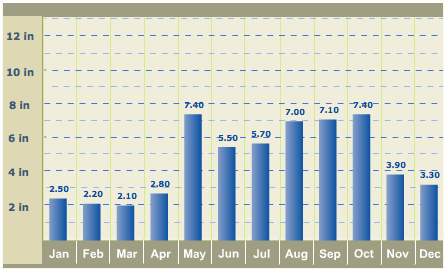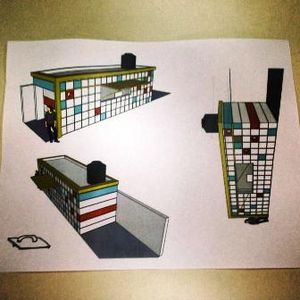
The following literature review page aims to explore the various factors that influence the implementation of the Botica Popular project in Las Malvinas.
Site Location[edit | edit source]
The project site is located in the semi-rural community of Las Malvinas, located in Santo Domingo Norte. The botica popular structure will be built along a local unpaved road and partially upon a cistern , which is located approximately in the center of the community.
Las Malvinas[edit | edit source]
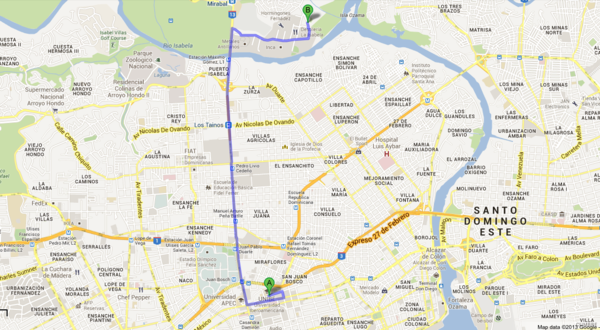
Climate[edit | edit source]
The Dominican Republic has a tropical climate. There is very little fluxuation in temperature through out the year. January averages are approximately 75 degrees Farenheit (24 degrees Celsius) and July average temperatures are approximately 81 degrees Farenheit (27 degrees Celsius).[1] During the rainy season (May through November) the Dominican Republic is very vulnerable to hurricanes. The majority of hurricane activity is during August and September.[2] According to The Weather Channel, the average rainfall per month is about 6.3 inches during the rainy season in Santo Domingo.[3]
Average Rainfall per Month in Santo Domingo
Plastic Bottle Waste[edit | edit source]
Ecoladrillo[edit | edit source]
The name is taken from ladrillo, a Spanish word for a brick or paving stone made from baked clay. Ecoladrillo allows otherwise discarded plastic bottles and trash to be used as a raw material for building construction.
Ecobricks of waste vs Ecobricks of clay[edit | edit source]
Ecobricks that utilize waste helps clean the environment by using non-recyclable materials to fill the bottles. The best materials are ones that serve no second purpose. For example, paper is recyclable and therefore not an optimal component for an ecobrick. Ecobricks made of polystyrene, aluminum, varieties of plastics, and other synthetic materials are potentially optimal for ecobrick filling. A list of possible wastes that could be used would include: food packaging old socks, razor blades, used up pens and markers, clothing tags, cotton swabs, and more. Make sure to use proper sanitary equipment when collecting trash (such as plastic gloves and trash bags). Children should have adult supervision when collecting trash to avoid any injuries, etc. Garbage must be relatively clean of food and always dry. This is important because it can cause mold and other unpredictable bacteria to form. Natural resources as water must be carefully used and conserved. Also avoid batteries and other toxic waste.[4] The process of mining clay out the ground requires much human power and causes environmental damage. Ecoclay bricks are typically heavier than ecobricks made out of waste.
Case Studies[edit | edit source]
| Project | Type | Picture | Description |
|---|---|---|---|
| House in Cochabamba, Bolivia | Horizontal ecoladrillos | 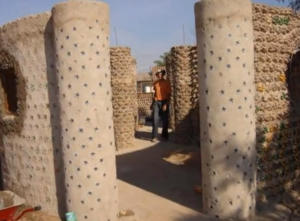 |
Carlos Morales designed the house without being either an architect or engineer by training, using more than 1,000,000 plastic bottles. The solution used is 1 part cement, 1 part red soil, 2 parts clay, 2 parts volcanic soil and 5 parts adobe.[5] |
| Doña Marta's House, | Vertical ecoladrillos | 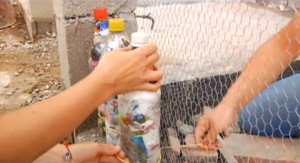 |
This solution includes the structure of the house consisting of ecoblocks and chicken wire on one side. Each ecoladrillo is secured to the chicken wire. The fillings of the approximately 3,500 plastic bottles used are 2.8 tons of waste.[6] |
| Pepsi + My Shelter Bottle School | Horizontal ecoladrillos filled with adobe + glass horizontal unfilled bottles | 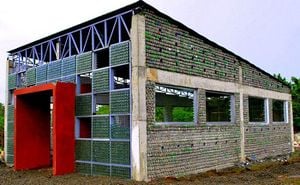 |
School house made of 9,000 1.5 and 2 litre plastic bottles in San Pablo, Philippines. Each was filled with adobe (sand, clay and wáter with a bit of straw, twigs or manure thrown in). String was used to keep the bottles in place as the adobe is applied. One wall is made of glass bottles without filling.[7] |
| Pura Vida School Houses in Guatemala | Vertical + horizontal ecoladrillos | 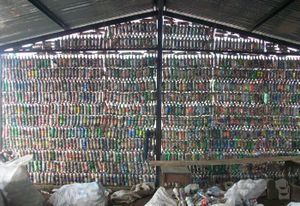 |
Students and volunteers worked together stuffing the plastic bottles and adding bags as stuffing to fill the gaps between bottles when building the wall. The cement used to fill the walls was donated. On the outside walls, three layers of cement were applied. Some schools use metal frames instead of cement posts.[8] |
Dos and Dont's[edit | edit source]
Dos
• Use synthetic materials (plastics, aluminum and things made out of polystyrene).
• Ensure the bottles will not collapse due to the weight above them.
• Clean and let dry completely all waste and bottles.
• Secure the bottles in a dry safe place with their caps on.
Dont's
• Do NOT use recyclable materials.
• Do NOT leave the bottles uncapped.
• Do NOT leave organic materials inside the bottles as this can cause mold and other bacteria to form.
[9][10]
Botica Popular[edit | edit source]
Botica popular is the name given to a small, government supported pharmacy in the Dominican Republic that caters to low-income families. They offer an array of basic medications (typically only generic) at a much lower cost.[11] The name “botica popular” appears to be a common term used to refer to pharmacies provided by the Ministry of Public Health’s Essential Drugs Program (Promese/Cal).[12] Available medications include antihypertensive, antiallergic, vitamins, cold remedies, analgesics, serums and suture material.[13]
Finishes[edit | edit source]
Sawdust[edit | edit source]
Not all sawdust is the same. There is a specific type of sawdust that needs to be used for making sawdust plaster.[14] It can’t be “wood flour” which is simply very fine sawdust, such as from a table saw. On the other end of the spectrum having wood that is too large and hard, like hardwood chips from a milling operation, is not what to search for as a sawdust plaster as well. The ideal sawdust for this ‘formula’ is from a softwood with a small shrinkage value, that has been cut at a mill or from a chainsaw.[15]
-
An example of sawdust flour. A bit finicky to mix with
-
Practicing with different ratios for the plaster on the prototypes.
Other[edit | edit source]
Flooring[edit | edit source]
Roofing[edit | edit source]
Metal Roofing[edit | edit source]
Corrugated metal roofing is a popular material in warmer climates. Metal roofs reflect the sun's rays and do not retain heat after the sun sets. Additionally, metal roofing such as tin or aluminum are lightweight, creating less structural pressure on the rest of the building.[16] The corrugated style makes for a more durable structure that can better withstand the elements.[17]
Other[edit | edit source]
Old cooking oil is a potential material to coat roofs in warm climates. This method is not expanded on in found readings, and may not be practical for this summer's project due to time constraints. However, considering that the the question of using old oil was brought up in class, we found it appropriate to mention for possible investigation in the future[18] Green/living roofs and solar/photovoltaic roofs are also options to keep in mind.
References[edit | edit source]
- ↑ Haberle, Susan E. Dominican Republic. Mankato, MN: Capstone, 2004. Print.
- ↑ http://dominican.peacecorps.gov/pcdr.php
- ↑ http://www.weather.com/weather/wxclimatology/monthly/graph/DRXX0009
- ↑ http://bottleschools.org/wiki/Making_“eco-bricks”
- ↑ http://www.youtube.com/watch?v=9GSh1t1Dujw
- ↑ http://www.youtube.com/watch?v=o81Kgt83ADg&feature=youtu.be
- ↑ http://www.inspirationgreen.com/plastic-bottle-schools.html
- ↑ http://www.inspirationgreen.com/plastic-bottle-schools.html
- ↑ http://web.archive.org/web/20130330235427/http://bottleschools.org:80/wiki/Making_%E2%80%9Ceco-bricks%E2%80%9D
- ↑ http://burketthoenefamilymission.blogspot.com/2013/05/eco-bricks.html
- ↑ http://forum.wordreference.com/showthread.php?t=33739&langid=24
- ↑ http://www.perspectivaciudadana.com/contenido.php?itemid=9899
- ↑ http://cosasdemontellano.blogspot.com/2008/04/inaugurarn-nuevo-local-botica-popular.html
- ↑ http://www.wood-report.de/pdf/coste31thess.pdf
- ↑ Snell, Clarke, and Tim Callahan. Building Green: A Complete How-to Guide to Alternative Building Methods. New York: Lark, 2005. Print.
- ↑ http://www.corrugatedmetalroofing.net/whatis.html
- ↑ http://www.corrugatedmetalroofing.net/whatis.html
- ↑ http://home.howstuffworks.com/home-improvement/construction/green/10-best-roofing-materials.htm#page=1
